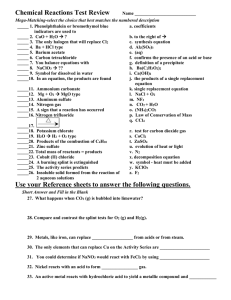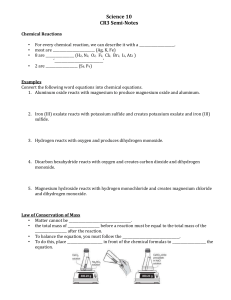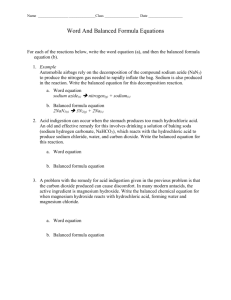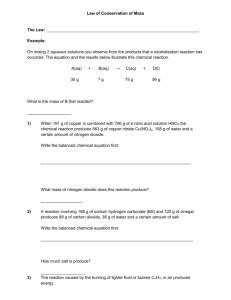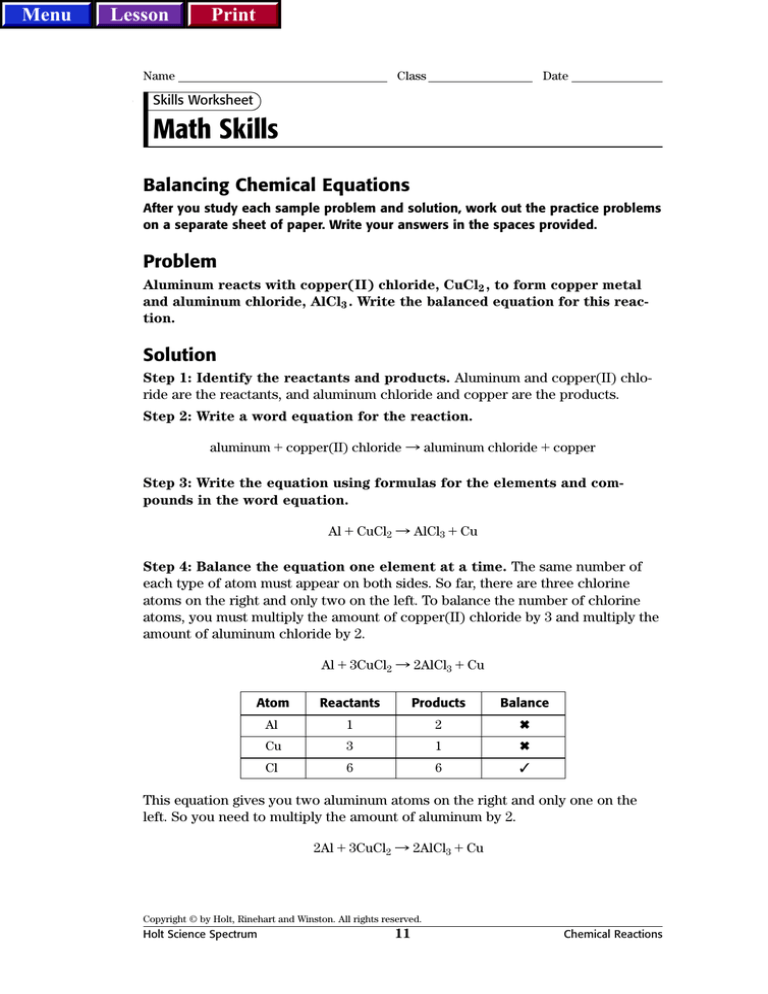
Menu
Lesson
Print
Name
Class
Date
Skills Worksheet
Math Skills
Balancing Chemical Equations
After you study each sample problem and solution, work out the practice problems
on a separate sheet of paper. Write your answers in the spaces provided.
Problem
Aluminum reacts with copper(II) chloride, CuCl2 , to form copper metal
and aluminum chloride, AlCl3 . Write the balanced equation for this reaction.
Solution
Step 1: Identify the reactants and products. Aluminum and copper(II) chloride are the reactants, and aluminum chloride and copper are the products.
Step 2: Write a word equation for the reaction.
aluminum copper(II) chloride : aluminum chloride copper
Step 3: Write the equation using formulas for the elements and compounds in the word equation.
Al CuCl2 : AlCl3 Cu
Step 4: Balance the equation one element at a time. The same number of
each type of atom must appear on both sides. So far, there are three chlorine
atoms on the right and only two on the left. To balance the number of chlorine
atoms, you must multiply the amount of copper(II) chloride by 3 and multiply the
amount of aluminum chloride by 2.
Al 3CuCl2 : 2AlCl3 Cu
Atom
Reactants
Products
Balance
Al
1
2
✖
Cu
3
1
✖
Cl
6
6
✓
This equation gives you two aluminum atoms on the right and only one on the
left. So you need to multiply the amount of aluminum by 2.
2Al 3CuCl2 : 2AlCl3 Cu
Copyright © by Holt, Rinehart and Winston. All rights reserved.
Holt Science Spectrum
11
Chemical Reactions
Menu
Lesson
Print
Name
Class
Date
Math Skills continued
Atom
Reactants
Products
Balance
Al
2
2
✓
Cu
3
1
✖
Cl
6
6
✓
To balance the equation, multiply the amount of copper produced by 3.
2Al 3CuCl2 : 2AlCl3 3Cu
Atom
Reactants
Products
Balance
Al
2
2
✓
Cu
3
3
✓
Cl
6
6
✓
Practice
1. Combustion in automobile engines takes place when fuel and oxygen are
combined and ignited in the cylinders of the engine. However, the air that
provides the oxygen for combustion also introduces nitrogen into the engine.
The nitrogen reacts with oxygen at the high temperatures present in the
engine, producing nitrogen oxide compounds, which are a major component
of smog. In one of these reactions, nitric oxide, NO, reacts with oxygen, O2 , to
form nitrogen dioxide, NO2 . Write the balanced equation for this reaction.
2. During the centuries following the collapse of the western Roman Empire,
marble (calcium carbonate, CaCO3) was taken from the monuments of Rome
and heated to form quicklime (calcium oxide, CaO), which was used to make
plaster. Carbon dioxide, CO2 , was also produced in this decomposition reaction. Write the balanced equation for this reaction.
3. When a match is lit, sulfur (S8) reacts with oxygen to release energy and form
sulfur dioxide, SO2 . Write the balanced equation for this reaction.
4. Zinc reacts with water to produce zinc hydroxide, Zn(OH)2 , and molecular
hydrogen gas, H2 . Write the balanced equation for this reaction.
5. Barium, Ba, reacts with sulfur, S8 , to form barium sulfide, BaS. Write the
balanced equation for this synthesis reaction.
Copyright © by Holt, Rinehart and Winston. All rights reserved.
Holt Science Spectrum
12
Chemical Reactions
Menu
Lesson
Print
Name
Class
Date
Math Skills continued
6. Automobile airbags rely on the decomposition of the compound sodium azide
(NaN3) to produce the nitrogen gas, N2 , needed to rapidly inflate the bag.
Sodium is also produced in the reaction. Write the balanced equation for this
decomposition reaction.
7. A useful single-displacement reaction involves thermite, which is a mixture of
aluminum and iron oxide, Fe2O3 . When the thermite reaches a high temperature, the components react to produce molten iron, aluminum oxide (Al2O3),
and a great deal of energy. Write the balanced equation for the thermite
reaction.
8. Acid indigestion can occur when the stomach produces too much hydrochloric acid, HCl. An old and effective remedy for this involves drinking a solution
of baking soda (sodium hydrogen carbonate, NaHCO3), which reacts with the
hydrochloric acid to produce sodium chloride (NaCl), water, and carbon
dioxide. Write the balanced equation for this reaction.
9. A problem with the remedy given in problem 8 for acid indigestion is that the
carbon dioxide produced can cause discomfort. In many modern antacids, the
active ingredient is magnesium hydroxide, Mg(OH)2 . When this compound
reacts with the hydrochloric acid, a double-displacement reaction occurs that
produces only water and magnesium chloride, MgCl2 . Write the balanced
equation for this reaction.
Problem
Write the equation that describes the formation of glucose and oxygen,
by means of photosynthesis, from carbon dioxide and water.
Solution
Step 1: Identify the reactants and products. Carbon dioxide and water, the
reactants, form glucose and oxygen, the products.
Step 2: Write a word equation for the reaction.
carbon dioxide water : glucose oxygen
Step 3: Write the equation using formulas for the elements and compounds in the word equation. Some gaseous elements are molecules, not
atoms. Oxygen in air is O2 , not O.
CO2 H2O : C6H12O6 O2
Copyright © by Holt, Rinehart and Winston. All rights reserved.
Holt Science Spectrum
13
Chemical Reactions
Menu
Lesson
Print
Name
Class
Date
Math Skills continued
Step 4: Balance the equation one element at a time. The same number of
each type of atom must appear on both sides. So far, there are six carbon atoms
on the right and only one on the left. To balance the number of carbon atoms,
multiply the amount of carbon dioxide by 6.
6CO2 H2O : C6H12O6 O2
Atom
Reactants
Products
Balance
C
6
6
✓
H
2
12
✖
O
13
8
✖
This equation gives you twelve hydrogen atoms on the right and only two on the
left. So you need to multiply the amount of water by 6.
6CO2 6H2O : C6H12O6 O2
Atom
Reactants
Products
Balance
C
6
6
✓
H
12
12
✓
O
18
8
✖
To balance the equation, multiply the amount of oxygen produced by 6.
6CO2 6H2O : C6H12O6 6O2
Atom
Reactants
Products
Balance
C
6
6
✓
H
12
12
✓
O
18
18
✓
Practice
10. Uranium reacts with fluorine gas, F2 , to form uranium(VI) fluoride, UF6 . Write
the balanced equation for this synthesis reaction.
11. Iron reacts with chlorine gas, Cl2 , to form iron(III) chloride, FeCl3 . Write the
balanced equation for this synthesis reaction.
12. Aluminum sulfate, Al2(SO4)3 , decomposes to form aluminum oxide, Al2O3, and
sulfur trioxide, SO3 . Write the balanced equation for this reaction.
Copyright © by Holt, Rinehart and Winston. All rights reserved.
Holt Science Spectrum
14
Chemical Reactions
Menu
Lesson
Print
Name
Class
Date
Math Skills continued
13. Water is decomposed by electrolysis to form the gaseous products hydrogen,
H2 , and oxygen, O2 . Write the balanced equation for this reaction.
14. Potassium chlorate, KClO3, decomposes to form potassium chloride, KCl, and
oxygen gas. Write the balanced equation for this decomposition reaction.
15. Chlorine gas, Cl2 , reacts with potassium bromide, KBr, to form potassium
chloride and bromine, Br2 . Write the balanced equation for this singledisplacement reaction.
16. Aluminum reacts with lead nitrate, Pb(NO3)2 , to form lead and aluminum
nitrate, Al(NO3)3 . Write the balanced equation for this single-displacement
reaction.
17. Ammonium chloride, NH4Cl, reacts with calcium hydroxide, Ca(OH)2 , to form
calcium chloride, CaCl2 , ammonia, NH3 , and water. Write the balanced equation for this reaction.
18. Zinc reacts with hydrochloric acid, HCl, to form zinc chloride, ZnCl2 , and
hydrogen gas. Write the balanced equation for this reaction.
19. Fluorine reacts with sodium chloride, NaCl, to form sodium fluoride, NaF, and
chlorine. Write the balanced equation for this single-displacement reaction.
(Hint: Remember that both fluorine and chlorine have two atoms per molecule when they are in elemental form.)
20. Calcium oxide, CaO, reacts with sulfur dioxide to form calcium sulfite,
CaSO3 . Write the balanced equation for this synthesis reaction.
21. In air, calcium sulfite, CaSO3, reacts slowly with oxygen to form calcium
sulfate, CaSO4 . Write the balanced equation for this reaction.
22. When heated, mercury(II) oxide, HgO, decomposes to form mercury and
oxygen. Through this reaction, Joseph Priestley demonstrated the existence
of oxygen in 1774. Write the balanced equation for the decomposition of
mercury(II) oxide.
Copyright © by Holt, Rinehart and Winston. All rights reserved.
Holt Science Spectrum
15
Chemical Reactions
Menu
Lesson
Print
Name
Class
Date
Math Skills continued
Mixed Practice
23. Potassium nitrate, KNO3, decomposes to form potassium nitrite, KNO2 , and
oxygen gas, O2 . Write the balanced equation for this decomposition reaction.
24. Antimony(V) chloride, SbCl5 , reacts with potassium iodide, KI, to form the
products potassium chloride, KCl, iodine, I2 , and antimony(III) chloride,
SbCl3 . Write the balanced equation for this reaction.
25. Nitric acid, HNO3, reacts with hydrogen sulfide, H2S, to form nitrogen dioxide,
NO2 , water, and sulfur, S. Write the balanced equation for this reaction.
26. Chromium(III) oxide, Cr2O3, reacts with silicon to form chromium metal and
silicon dioxide, SiO2 . Write the balanced equation for this reaction.
27. Ammonium dichromate, (NH4)2Cr2O7 , decomposes to form chromium(III)
oxide, Cr2O3, nitrogen gas, N2 , and water. Write the balanced equation for this
decomposition reaction.
28. Iron(II) chloride, FeCl2 , reacts with water at high temperatures to form triiron
tetraoxide, Fe3O4 , hydrochloric acid, and hydrogen gas. Write the balanced
equation for this reaction.
29. Aluminum sulfate, Al2(SO4)3 , reacts with calcium hydroxide, Ca(OH)2 , to
form aluminum hydroxide, Al(OH)3 , and calcium sulfate, CaSO4 . Write the
balanced equation for this double-displacement reaction.
30. Lead chloride, PbCl2 , reacts with sodium chromate, Na2CrO4 , to form lead
chromate, PbCrO4 , and sodium chloride, NaCl. Write the balanced equation
for this double-displacement reaction.
31. Vanadium pentoxide, V2O5 , reacts with calcium to form vanadium metal and
calcium oxide, CaO. Write the balanced equation for this reaction.
Copyright © by Holt, Rinehart and Winston. All rights reserved.
Holt Science Spectrum
16
Chemical Reactions
Menu
Lesson
Print
TEACHER RESOURCE PAGE
Science Skills
7.
8.
9.
10.
11.
12.
13.
14.
15.
16.
17.
BALANCING CHEMICAL EQUATIONS
1. No; the equation is not balanced
2.
3.
4.
5.
6.
because there are 2 N atoms on the
left side and 1 N atoms on the right
side, and 4 O atoms on the left side
and 2 O atoms on the right side.
2H2 O2 : 2H2O
CH4 2O2 : CO2 2H2O
4Fe 3O2 : 2Fe2O3
C6H12O6 6O2 : 6CO2 6H2O
The equation is already balanced.
18.
19.
20.
21.
22.
23.
24.
25.
26.
27.
28.
29.
RATIOS AND PROPORTIONS
1. 6 cups of water
2. 21 male teachers
3. x 600
Math Skills
BALANCING CHEMICAL EQUATIONS
1.
2.
3.
4.
5.
6.
2NO O2 : 2NO2
CaCO3 : CaO CO2
S8 8O2 : 8SO2
Zn 2H2O : Zn(OH)2 H2
8Ba S8 : 8BaS
2NaN3 : 2Na 3N2
30.
31.
2Al Fe2O3 : 2Fe Al2O3
NaHCO3 HCl : NaCl H2O CO2
Mg(OH)2 2HCl : MgCl2 2H2O
U 3F2 : UF6
2Fe 3Cl2 : 2FeCl3
Al2(SO4)3 : Al2O3 3SO3
2H2O : 2H2 O2
2KClO3 : 2KCl 3O2
2KBr Cl2 : 2KCl Br2
2Al 3Pb(NO3)2 : 3Pb 2Al(NO3)3
2NH4Cl Ca(OH)2
: CaCl2 2NH3 2H2O
Zn 2HCl : ZnCl2 H2
2NaCl F2 : 2NaF Cl2
CaO SO2 : CaSO3
2CaSO3 O2 : 2CaSO4
2HgO : 2Hg O2
2KNO3 : 2KNO2 O2
SbCl5 2KI : 2KCl I2 SbCl3
2HNO3 H2S : 2NO2 2H2O S
2Cr2O3 3Si : 4Cr 3SiO2
(NH4)2Cr2O7 : Cr2O3 N2 4H2O
3FeCl2 4H2O : Fe3O4 6HCl H2
Al2(SO4)3 3Ca(OH)2
: 2Al(OH)3 3CaSO4
PbCl2 Na2CrO4 : PbCrO4 2NaCl
V2O5 5Ca : 2V 5CaO
Copyright © by Holt, Rinehart and Winston. All rights reserved.
Holt Science Spectrum
89
Chemical Reactions

